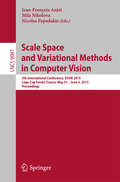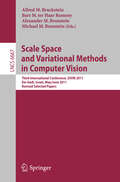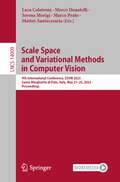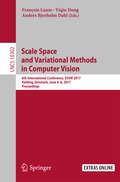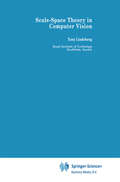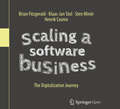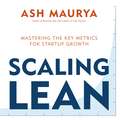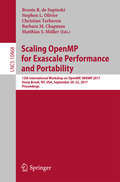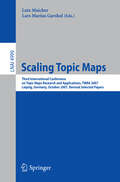- Table View
- List View
Scale-Space and Morphology in Computer Vision: Third International Conference, Scale-Space 2001, Vancouver, Canada, July 7-8, 2001. Proceedings (Lecture Notes in Computer Science #2106)
by Michael KerckhoveThis book constitutes the refereed proceedings of the Third International Conference on Scale-Space and Morphology in Computer Vision, Scale-Space 2001, held in Vancouver, Canada in July 2001.The 18 revised full papers presented together with 23 posters were carefully reviewed and selected from 60 submissions. The book addresses all current aspects of scale-space and morphology in the context of computer vision, in particular, vector distance functions, optic flow, image registration, curve evolution, morphological segmentation, scalar images, vector images, automatic scale selection, geometric diffusion, diffusion filtering, image filtering, inverse problems, active contours, etc.
Scale Space and PDE Methods in Computer Vision: 5th International Conference, Scale-Space 2005, Hofgeismar, Germany, April 7-9, 2005, Proceedings (Lecture Notes in Computer Science #3459)
by Ron Kimmel Nir Sochen Joachim WeickertWelcome to the proceedings of the 5th International Conference on Scale-Space and PDE Methods in Computer Vision. The scale-space concept was introduced by Iijima more than 40 years ago and became popular later on through the works of Witkin and Koenderink. It is at the junction of three major schools of thought in image processing and computer vision: the design of ?lters, axiomatic approaches based on partial di?erential equations (PDEs), and variational methods for image regularization. Scale-space ideas belong to the mathematically best-understood approaches in image analysis. They have entered numerous successful applications in medical imaging and a number of other ?elds where they often give results of very high quality. This conference followed biennial meetings held in Utrecht, Corfu, Vancouver and Skye. It took place in a little castle (Schl¨ osschen Sch¨ onburg) near the small town of Hofgeismar, Germany. Inspired by the very successful previous meeting at Skye, we kept the style of gathering people in a slightly remote and scenic place in order to encourage many fruitful discussions during the day and in the evening. Wereceived79fullpapersubmissionsofahighstandardthatischaracteristic for the scale-space conferences. Each paper was reviewed by three experts from the Program Committee, sometimes helped by additional reviewers. Based on theresultsofthesereviews,53paperswereaccepted.Weselected24manuscripts for oral presentation and 29 for poster presentation.
Scale Space and Variational Methods in Computer Vision: 5th International Conference, SSVM 2015, Lège-Cap Ferret, France, May 31 - June 4, 2015, Proceedings (Lecture Notes in Computer Science #9087)
by Jean-François Aujol Mila Nikolova Nicolas PapadakisThis book constitutes the refereed proceedings of the 5th International Conference on Scale Space and Variational Methods in Computer Vision, SSVM 2015, held in Lège-Cap Ferret, France, in May 2015. The 56 revised full papers presented were carefully reviewed and selected from 83 submissions. The papers are organized in the following topical sections: scale space and partial differential equation methods; denoising, restoration and reconstruction, segmentation and partitioning; flow, motion and registration; photography, texture and color processing; shape, surface and 3D problems; and optimization theory and methods in imaging.
Scale Space and Variational Methods in Computer Vision: Third International Conference, SSVM 2011, Ein-Gedi, Israel, May 29 -- June 2, 2011, Revised Selected Papers (Lecture Notes in Computer Science #6667)
by Michael M. Bronstein Alfred M. Bruckstein Bart M. Ter Haar Romeny Alexander M. BronsteinThis book constitutes the thoroughly refereed post-conference proceedings of the Third International Conference on Scale Space Methods and Variational Methods in Computer Vision, SSVM 2011, held in Ein-Gedi, Israel in May/June 2011. The 24 revised full papers presented together with 44 poster papers were carefully reviewed and selected from 78 submissions. The papers are organized in topical sections on denoising and enhancement, segmentation, image representation and invariants, shape analysis, and optical flow.
Scale Space and Variational Methods in Computer Vision: 9th International Conference, SSVM 2023, Santa Margherita di Pula, Italy, May 21–25, 2023, Proceedings (Lecture Notes in Computer Science #14009)
by Luca Calatroni Marco Donatelli Serena Morigi Marco Prato Matteo SantacesariaThis book constitutes the proceedings of the 9th International Conference on Scale Space and Variational Methods in Computer Vision, SSVM 2023, which took place in Santa Margherita di Pula, Italy, in May 2023. The 57 papers presented in this volume were carefully reviewed and selected from 72 submissions. They were organized in topical sections as follows: Inverse Problems in Imaging; Machine and Deep Learning in Imaging; Optimization for Imaging: Theory and Methods; Scale Space, PDEs, Flow, Motion and Registration.
Scale Space and Variational Methods in Computer Vision: 8th International Conference, SSVM 2021, Virtual Event, May 16–20, 2021, Proceedings (Lecture Notes in Computer Science #12679)
by Abderrahim Elmoataz Jalal Fadili Yvain Quéau Julien Rabin Loïc SimonThis book constitutes the proceedings of the 8th International Conference on Scale Space and Variational Methods in Computer Vision, SSVM 2021, which took place during May 16-20, 2021. The conference was planned to take place in Cabourg, France, but changed to an online format due to the COVID-19 pandemic.The 45 papers included in this volume were carefully reviewed and selected from a total of 64 submissions. They were organized in topical sections named as follows: scale space and partial differential equations methods; flow, motion and registration; optimization theory and methods in imaging; machine learning in imaging; segmentation and labelling; restoration, reconstruction and interpolation; and inverse problems in imaging.
Scale Space and Variational Methods in Computer Vision: 4th International Conference, SSVM 2013, Schloss Seggau, Graz, Austria, June 2-6, 2013, Proceedings (Lecture Notes in Computer Science #7893)
by Arjan Kuijper Kristian Bredies Thomas Pock Horst BischofThis book constitutes the refereed proceedings of the 4th International Conference on Scale Space Methods and Variational Methods in Computer Vision, SSVM 2013, held in Schloss Seggau near Graz, Austria, in June 2013. The 42 revised full papers presented were carefully reviewed and selected 69 submissions. The papers are organized in topical sections on image denoising and restoration, image enhancement and texture synthesis, optical flow and 3D reconstruction, scale space and partial differential equations, image and shape analysis, and segmentation.
Scale Space and Variational Methods in Computer Vision: 6th International Conference, SSVM 2017, Kolding, Denmark, June 4-8, 2017, Proceedings (Lecture Notes in Computer Science #10302)
by François Lauze Yiqiu Dong Anders Bjorholm DahlThis book constitutes the refereed proceedings of the 6th International Conference on Scale Space and Variational Methods in Computer Vision, SSVM 2017, held in Kolding, Denmark, in June 2017. The 55 revised full papers presented were carefully reviewed and selected from 77 submissions. The papers are organized in the following topical sections: Scale Space and PDE Methods; Restoration and Reconstruction; Tomographic Reconstruction; Segmentation; Convex and Non-Convex Modeling and Optimization in Imaging; Optical Flow, Motion Estimation and Registration; 3D Vision.
Scale Space and Variational Methods in Computer Vision: 7th International Conference, SSVM 2019, Hofgeismar, Germany, June 30 – July 4, 2019, Proceedings (Lecture Notes in Computer Science #11603)
by Jan Lellmann Martin Burger Jan ModersitzkiThis book constitutes the proceedings of the 7th International Conference on Scale Space and Variational Methods in Computer Vision, SSVM 2019, held in Hofgeismar, Germany, in June/July 2019. The 44 papers included in this volume were carefully reviewed and selected for inclusion in this book. They were organized in topical sections named: 3D vision and feature analysis; inpainting, interpolation and compression; inverse problems in imaging; optimization methods in imaging; PDEs and level-set methods; registration and reconstruction; scale-space methods; segmentation and labeling; and variational methods.
Scale Space and Variational Methods in Computer Vision: Second International Conference, SSVM 2009, Voss, Norway, June 1-5, 2009. Proceedings (Lecture Notes in Computer Science #5567)
by Marius Lysaker Knut-Andreas Lie Xue-Cheng Tai Knut MorkenThis book contains 71 original, scienti?c articles that address state-of-the-art researchrelatedto scale space and variationalmethods for image processing and computer vision. Topics covered in the book range from mathematical analysis of both established and new models, fast numerical methods, image analysis, segmentation, registration, surface and shape construction and processing, to real applications in medical imaging and computer vision. The ideas of scale spaceandvariationalmethodsrelatedtopartialdi?erentialequationsarecentral concepts. The papers re?ect the newest developments in these ?elds and also point to the latest literature. All the papers were submitted to the Second International Conference on Scale Space and Variational Methods in Computer Vision, which took place in Voss, Norway, during June 1–5, 2009. The papers underwent a peer review process similar to that of high-level journals in the ?eld. We thank the authors, the Scienti?c Committee, the Program Committee and the reviewers for their hard work and helpful collaboration. Their contribution has been crucial for the e?cient processing of this book, and for the success of the conference.
Scale Space and Variational Methods in Computer Vision: First International Conference, SSVM 2007, Ischia, Italy, May 30 - June 2, 2007, Proceedings (Lecture Notes in Computer Science #4485)
by Fiorella Sgallari Almerico Murli Nikos ParagiosThis book constitutes the refereed proceedings of the First International Conference on Scale Space Methods and Variational Methods in Computer Vision, SSVM 2007, emanated from the joint edition of the 4th International Workshop on Variational, Geometric and Level Set Methods in Computer Vision, VLSM 2007 and the 6th International Conference on Scale Space and PDE Methods in Computer Vision, Scale-Space 2007, held in Ischia Italy, May/June 2007.
Scale Space Methods in Computer Vision: 4th International Conference, Scale-Space 2003, Isle of Skye, UK, June 10-12, 2003, Proceedings (Lecture Notes in Computer Science #2695)
by Lewis D. Griffin Martin LillholmThe refereed proceedings of the 4th International Conference on Scale Space Methods in Computer Vision, Scale-Space 2003, held at Isle of Skye, UK in June 2003. The 56 revised full papers presented were carefully reviewed and selected from 101 submissions. The book offers topical sections on deep structure representations, scale space mathematics, equivalences, implementing scale spaces, minimal approaches, evolution equations, local structure, image models, morphological scale spaces, temporal scale spaces, shape, and motion and stereo.
Scale-Space Theories in Computer Vision: Second International Conference, Scale-Space'99, Corfu, Greece, September 26-27, 1999, Proceedings (Lecture Notes in Computer Science #1682)
by Mads Nielsen Peter Johansen Ole F. Olsen Joachim WeickertThis volume constitutes the refereed proceedings of the Second International Conference on Scale-Space Theories in Computer Vision, Scale-Space'99, held in Corfu, Greece, in September 1999.The 36 revised full papers and the 18 revised posters presented in the book were carefully reviewed and selected from 66 high-quality submissions. The book addresses all current aspects of this young and active field, in particular geometric Image flows, nonlinear diffusion, functional minimization, linear scale-space, etc.
Scale-Space Theory in Computer Vision (The Springer International Series in Engineering and Computer Science #256)
by Tony LindebergThe problem of scale pervades both the natural sciences and the vi sual arts. The earliest scientific discussions concentrate on visual per ception (much like today!) and occur in Euclid's (c. 300 B. C. ) Optics and Lucretius' (c. 100-55 B. C. ) On the Nature of the Universe. A very clear account in the spirit of modern "scale-space theory" is presented by Boscovitz (in 1758), with wide ranging applications to mathemat ics, physics and geography. Early applications occur in the cartographic problem of "generalization", the central idea being that a map in order to be useful has to be a "generalized" (coarse grained) representation of the actual terrain (Miller and Voskuil 1964). Broadening the scope asks for progressive summarizing. Very much the same problem occurs in the (realistic) artistic rendering of scenes. Artistic generalization has been analyzed in surprising detail by John Ruskin (in his Modern Painters), who even describes some of the more intricate generic "scale-space sin gularities" in detail: Where the ancients considered only the merging of blobs under blurring, Ruskin discusses the case where a blob splits off another one when the resolution is decreased, a case that has given rise to confusion even in the modern literature.
Scaling a Software Business: The Digitalization Journey
by Brian Fitzgerald Klaas-Jan Stol Sten Minör Henrik CosmoThis book is open access under a CC BY 4.0 license.This book is intended primarily for practitioners who are facing the “softwareisation” of their business. It presents the Scaling Management Framework, a model based on collected experiences from companies that have already made the journey to give software a central role within the organization. The model is unique because it suggests a holistic method to analyze and plan your journey. It simply means that you can’t just focus solely on your products or services. You also have to look closely at your processes and your organization, the way you make decisions and get things done. Inevitably, these will have to change.Software has changed the rules of the game. The world talks about the digitalization in industry and society – how the focus has shifted from producing tangible things towards software and services. This trend started many years ago, but is now affecting every company, whether it’s a software company or not. There are many companies that have already made a digitalization journey – and many are about to embark on this journey – like you. How do you transform your organization when software is becoming a critical part of your business?This book comes with a map, a compass, and suggested journeys along with selected travel stories comprising best practices and lessons learned from past digitalization journeys. Use the map to find your way in the digitalization landscape, and use the compass to find the direction of your journey.
Scaling Agile with Jira Align?: A practical guide to strategically scaling agile across teams, programs, and portfolios in enterprises
by Dean MacNeil Aslam CaderAccelerate business value delivery with Jira Align, the enterprise agile planning platform, by connecting strategy with execution to maximize outcomesKey FeaturesImprove coordination and transparency between multiple programs, products, and business portfoliosIncrease customer satisfaction by responding quickly to ever-evolving customer needsDeliver higher quality products faster and more predictably with real-time insights and OKR trackingBook DescriptionJira Align is a platform purpose-built for enterprises to connect strategy with execution and drive transparency, consistency, and predictability at all levels of scale. The platform supports business value delivery in agile frameworks such as LeSS, DAD, and SAFe. It also caters to organizations that mix agile with waterfall to support scaled bimodal delivery.Starting with an introduction to the platform and its features, this book takes you through the foundational building blocks of Jira Align. You'll learn how an organization can benefit from implementing Jira Align and understand how to connect dimensions such as people, work, time, and outcomes. The book takes you through the typical steps for implementing Jira Align for maximizing outcomes and helps you solve common team, program, and portfolio-level challenges by enhancing visibility, tracking dependencies and risks, and using reports for real-time, distributed decision making. Throughout the book, you'll explore features such as remote agile ceremonies, live roadmaps, and objectives and key results (OKRs). You'll also get to grips with lean portfolio management, financial reporting, and using the program board for planning and execution.By the end of this book, you'll be well versed in the key features of Jira Align and be able to leverage them to support all levels of agile at scale.What you will learnUnderstand Jira Align's key factors for successFind out how you can connect people, work, time, and outcomes with Jira AlignNavigate and collaborate in Jira AlignScale team agility to the portfolio and enterpriseDelve into planning and execution, including roadmaps and predictability metricsImplement lean portfolio management and OKRsGet to grips with handling bimodal and hybrid deliveryEnable advanced data security and analytics in Jira AlignWho this book is forThis book is for portfolio managers, program managers, product managers, product owners, executives, release train engineers, and scrum masters who want to empower their teams to deliver the right things at the right time and quickly respond to changes in the market. Familiarity with agile frameworks and Jira Software is necessary; the book will teach you the rest.
Scaling Apache Solr
by Hrishikesh Vijay KarambelkarThis book is a step-by-step guide for readers who would like to learn how to build complete enterprise search solutions, with ample real-world examples and case studies. If you are a developer, designer, or architect who would like to build enterprise search solutions for your customers or organization, but have no prior knowledge of Apache Solr/Lucene technologies, this is the book for you.
Scaling Big Data with Hadoop and Solr
by Hrishikesh KarambelkarThis book is a step-by-step tutorial that will enable you to leverage the flexible search functionality of Apache Solr together with the Big Data power of Apache Hadoop. Scaling Big Data with Hadoop and Solr provides guidance to developers who wish to build high-speed enterprise search platforms using Hadoop and Solr. This book is primarily aimed at Java programmers who wish to extend the Hadoop platform to make it run as an enterprise search without any prior knowledge of Apache Hadoop and Solr.
Scaling Big Data with Hadoop and Solr - Second Edition
by Hrishikesh Vijay KarambelkarThis book is aimed at developers, designers, and architects who would like to build big data enterprise search solutions for their customers or organizations. No prior knowledge of Apache Hadoop and Apache Solr/Lucene technologies is required.
Scaling Cloud FinOps: Proven Strategies to Accelerate Financial Success
by Sasi Kanumuri Matthew ZeierResponding to the escalating demands placed on organizations and enterprises as they navigate the intricacies of cloud economics, this book offers pragmatic insights for establishing a sturdy foundation for cloud cost management. Scaling Cloud FinOps empowers you with the knowledge and strategies to harness efficient cloud technology usage to proficiently manage cloud costs, refine expenditure, and implement robust, scalable Cloud FinOps practices. At the same time, it arms engineering leaders and executives with the necessary tools to foster a culture of cost awareness critical to greater profitability. At the heart of the book lies author Sasi Kanumuri’s #Piggy-Bank Framework, an innovative approach to cloud cost governance that offers a practical blueprint to streamline cost reporting, provisioning, and resource management through automation, efficiency, and overall financial performance. You’ll also delve into the intricacies of the 6-factor formula, a proven approach to cloud cost management. From resource rightsizing and cost allocation models to automated guardrails and vendor management, each factor serves as a pillar to support your organization's financial goals. Looking beyond numbers, Scaling Cloud FinOps will give you the tools needed to orchestrate a cultural shift that can permeate every aspect of your organization. You'll learn how to cultivate a cost-aware engineering culture in which financial policies give every team member the knowledge and motivation to make data-driven decisions that drive efficiency, unlocking significant cost savings and cloud financial excellence. What You Will Learn Cultivate a culture of cost awareness and accountability within engineering teams, fostering collaboration and data-driven decision-making to enhance cloud efficiency Best practices from FinOps pioneers who've scaled world-class FinOps Teams at tech giants and startups Explore unique frameworks enriched with real-world case studies, providing invaluable insights into effective cloud cost management (CCM) Acquire expert techniques in cost optimization, automation, and vendor management, all proven to deliver significant savings and optimal efficacy Who This Book Is For Professionals and leaders across the cloud, IT, finance, and procurement industries interested in streamlining cloud expenditures, cultivating a culture of cost awareness across the organization, and establishing robust cloud cost management strategies. Whether you're a novice or seasoned in FinOps practices, this book equips you with the tools to maximize the business value of your cloud investments.
Scaling Lean: Mastering the Key Metrics for Startup Growth
by Ash Maurya'A battle-tested approach to building companies that matter' - Eric Ries, author of The Lean StartupIs your 'big idea' worth pursuing? What if you could test your business model earlier in the process - before you've expended valuable time and resources?You've talked to customers. You've identified problems that need solving, and maybe even built a minimum viable product. But now there's a second bridge to cross. How do you tell whether your idea represents a viable business? Do you really have to go through the whole cycle of development, failure, iteration, tweak, repeat? Scaling Lean offers an invaluable blueprint for modelling startup success. You'll learn the essential metrics that measure the output of a working business model, give you the pulse of your company, communicate its health to investors, and enable you to make precise interventions when things go wrong.Ash Maurya, a serial entrepreneur and author of the startup cult classic Running Lean, pairs real-world examples of startups like Airbnb and Hubspot with techniques from the manufacturing world in this tactical handbook for scaling with maximum efficiency and efficacy. This is vital reading for any startup founder graduating from the incubator stage.
Scaling of Differential Equations (Simula SpringerBriefs on Computing #2)
by Hans Petter Langtangen Geir K. PedersenThe book serves both as a reference for various scaled models with corresponding dimensionless numbers, and as a resource for learning the art of scaling. A special feature of the book is the emphasis on how to create software for scaled models, based on existing software for unscaled models. Scaling (or non-dimensionalization) is a mathematical technique that greatly simplifies the setting of input parameters in numerical simulations. Moreover, scaling enhances the understanding of how different physical processes interact in a differential equation model. Compared to the existing literature, where the topic of scaling is frequently encountered, but very often in only a brief and shallow setting, the present book gives much more thorough explanations of how to reason about finding the right scales. This process is highly problem dependent, and therefore the book features a lot of worked examples, from very simple ODEs to systems of PDEs, especially from fluid mechanics. The text is easily accessible and example-driven. The first part on ODEs fits even a lower undergraduate level, while the most advanced multiphysics fluid mechanics examples target the graduate level. The scientific literature is full of scaled models, but in most of the cases, the scales are just stated without thorough mathematical reasoning. This book explains how the scales are found mathematically. This book will be a valuable read for anyone doing numerical simulations based on ordinary or partial differential equations.
Scaling OpenMP for Exascale Performance and Portability: 13th International Workshop on OpenMP, IWOMP 2017, Stony Brook, NY, USA, September 20–22, 2017, Proceedings (Lecture Notes in Computer Science #10468)
by Bronis R. de Supinski Stephen L. Olivier Christian Terboven Barbara M. Chapman Matthias S. MüllerThis book constitutes the proceedings of the 13th International Workshop on OpenMP, IWOMP 2017, held in Stony Brook, NY, USA, in September 2017. The 23 full papers presented in this volume were carefully reviewed and selected from 28 submissions. They were organized in topical sections named: Advanced Implementations and Extensions; OpenMP Application Studies; Analyzing and Extending Tasking; OpenMP 4 Application Evaluation; Extended Parallelism Models: Performance Analysis and Tools; and Advanced Data Management with OpenMP.
Scaling Scrum Across Modern Enterprises: Implement Scrum and Lean-Agile techniques across complex products, portfolios, and programs in large organizations
by Cecil Rupp Manjit SinghEstablish business agility in your organization by applying industry-proven scaling strategies from popular Scrum frameworks such as Scrum of Scrums (SoS), Scrum@Scale, Nexus, Large-Scale Scrum (LeSS), Disciplined Agile, and SAFe Key Features Learn how to be Agile at scale by implementing best practices Understand how Lean-Agile practices are incorporated in Disciplined Agile and the Scaled Agile Framework (SAFe) Customize Scrum and Lean-Agile practices to support portfolio and large product development needs Book Description Scaled Scrum and Lean-Agile practices provide essential strategies to address large and complex product development challenges not addressed in traditional Scrum. This Scrum/ Lean-Agile handbook provides a comprehensive review and analysis of industry-proven scaling strategies that enable business agility on an enterprise scale. Free of marketing hype or vendor bias, this book helps you decide which practices best fit your situation. You'll start with an introduction to Scrum as a lightweight software development framework and then explore common approaches to scaling it for more complex development scenarios. The book will then guide you through systems theory, lean development, and the application of holistic thinking to more complex software and system development activities. Throughout, you'll learn how to support multiple teams working in collaboration to develop large and complex products and explore how to manage cross-team integration, dependency, and synchronization issues. Later, you'll learn how to improve enterprise operational efficiency across value creation and value delivery activities, before discovering how to align product portfolio investments with corporate strategies. By the end of this Scrum book, you and your product teams will be able to get the most value out of Agile at scale, even in complex cyber-physical system development environments. What you will learn Understand the limitations of traditional Scrum practices Explore the roles and responsibilities in a scaled Scrum and Lean-Agile development environment Tailor your Scrum approach to support portfolio and large product development needs Apply systems thinking to evaluate the impacts of changes in the interdependent parts of a larger development and delivery system Scale Scrum practices at both the program and portfolio levels of management Understand how DevOps, test automation, and CI/CD capabilities help in scaling Scrum practices Who this book is for Executives, product owners, Scrum masters, development team members, and other stakeholders who need to learn how to scale Agile to support large, complex projects and large enterprise portfolios and programs will find this book useful. A basic understanding of the values and principles of Agile and the Scrum-based framework for Agile development practices is required before you get started with this Agile Scrum book.
Scaling Topic Maps: Third International Conference on Topic Map Research and Applications, TMRA 2007 Leipzig, Germany, October 11-12, 2007 Revised Selected Papers (Lecture Notes in Computer Science #4999)
by Lutz Maicher Lars Marius GarsholThe papers in this volume were presented at TMRA 2007, the International Conference on Topic Maps Research and Applications, held October 11–12, 2007, in Leipzig, Germany. TMRA 2007 was the third conference in an annual series of international conferences dedicated to Topic Maps in science and industry. The motto of TMRA 2007 was “Scaling Topic Maps.” Taken literally the motto implies developing Topic Maps approaches that scale to large data and user volumes. This is a very real and useful research problem which is addressed by many of the contributions to the conference. But there is an even broader interpretation of the motto: wide adoption of Topic Maps in academia and industry. This is an equally important problem, and one that the TMRA conference series exists to help solve. And there is a more fanciful view on the motto. To “scale” can also mean to climb, so for the attendees the conference provided a way to “scale the mountain of Topic Maps.” In all these ways TMRA 2007 helped to scale Topic Maps.


